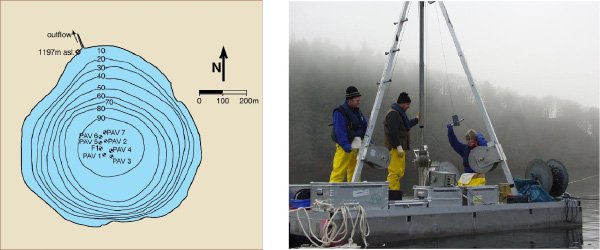Vegetation history, human impact and climate change recorded in annual laminated sediments from Lac Pavin (Massif Central, France)
Pollen and diatom assemblages from annually laminated lake sediments record vegetation and environmental histories. Variations in varve thickness, paleomagnetic and geochemical parameters indicate changes in precipitation and temperature that can be translated with transfer functions developed from biogenic and sedimentologic proxies.
The Pavin maar is the youngest volcano of the Chaîne des Puys (Massif Central, France) with an age of the volcano still under debate. Lac Pavin (45°55'N; 2°54'E) is located in a remote area about 1200m asl. being circular in shape with a mean diameter of 750m and a maximum depth of 92m. The water column is characterised by a permanently anoxic monimolimnion.
Analyses of diatoms, pollen, sedimentology and geochemistry have been undertaken on a 180 cm long surface core. Distinct silty laminae contain diatoms, vivianite and siderite. The laminae comprise several diatom species with distinct layers consisting mainly of one or two planktonic species. These mono- or duospecific layers alternate with layers mostly comprising benthic species, such as Epithemia spp., Fragilaria spp., Rhopalodia spp. and others, in addition to siderite, vivianite and organic particles. The seasonal variations in these diatom blooms indicate that the laminations represent annual layers. On the basis of preliminary varve chronology, the analysed sediment sequence covers the last 600-700 years.
Additionally, a 1102 cm long core was recovered in winter 2001/02 to enable the reconstruction of the paleoclimate for the last ~ 6,000 yrs on an annual scale. A composite profile from the laminated olive green up to black sediment was made from two parallel cores. Thin section investigations using a light microscope allow counting of the varves and produce, in combination with the biological investigations, a chronology. The investigations are still under way.
Our first results are:
- Although the paleoclimatic interpretation of the sedimentological change (1575-1780) is still a matter of debate it appears to be coincident with the climatic cooling of the so called Little Ice Age.
- A climatic cause of the change in varve composition is supported by general decrease in the content of diatom frustules (lower productivity), changing geochemistry (siderite) and changing pollen composition (analyses in progress).
- Sediments of Lac Pavin allow the reconstruction of paleoenvironment and probably of paleo-climate, for approximately the last 6000 years. In combination of varve counting and AMS 14C data we will get a new high resoluted paleo-archive.
Our further scientific questions are:
- What are the factors controlling long-term climatic trends and short-term climate variability?
- Can the influence of the Atlantic Ocean, for example the North Atlantic Oscillation (NAO), be detected and what evidence is there of periodicities and variations in its intensity on the European climate?
- How old is the youngest volcanic activity in Massif Central?
- How has climate varied along the west to east or marine to continental transect?
- Is there any relationship between the responses of natural ecosystems to climate change and the development of human societies?




